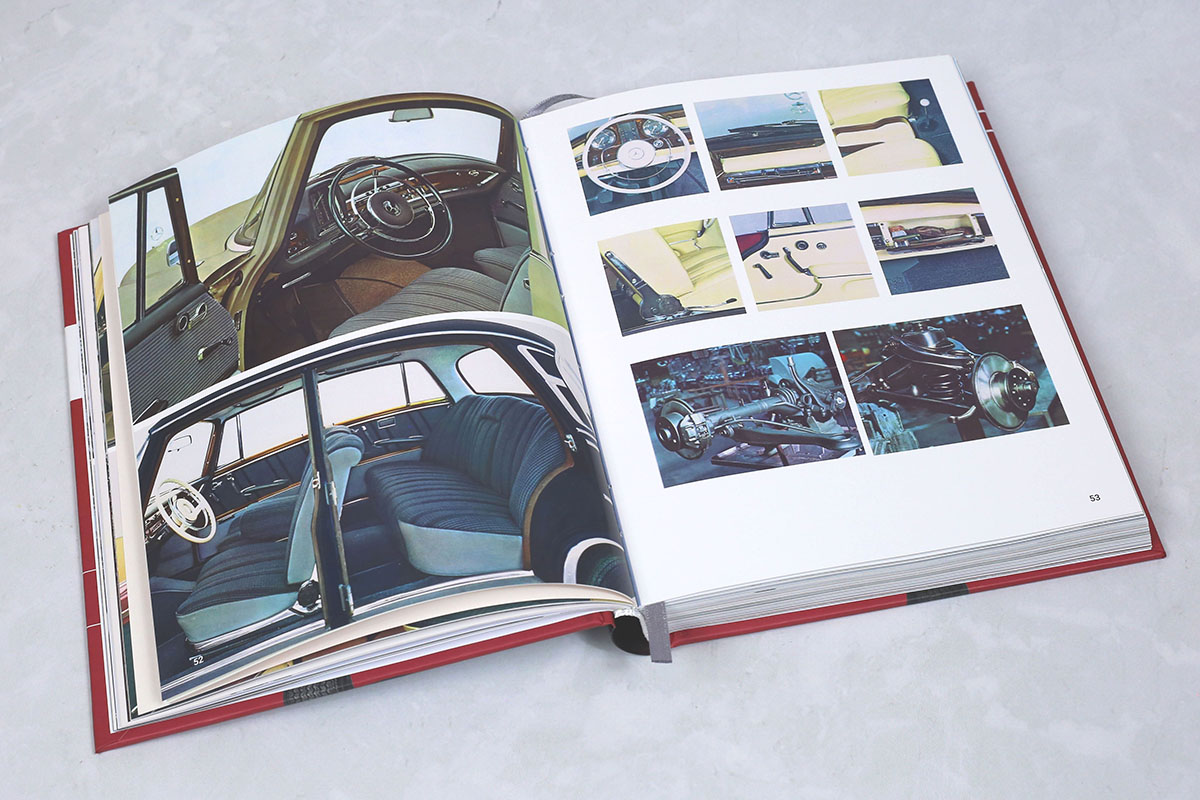Description
Mercedes-Benz W108-W112 Hardcover book (fragment of the text)
The appearance of the new family of Mercedes-Benz executive sedans was preceded by the painstaking work of talented engineer Béla Barényi.
After graduating from the mechanical department of the Vienna Technical School in 1926, he worked for several automobile companies: Austro-Daimler, Steyr, and Adler.
Having gained experience, Barényi became a member of the Daimler-Benz team in 1939. In the post-war years, he concentrated his efforts on the topic of car safety, which resulted in a body structure with deformation zones patented in 1952.
This solution made it possible to preserve the integrity of the passenger compartment by absorbing the impact energy of the removable zones in the front and rear parts of the body.
The W111/112 sedan was the first production passenger car in the world to use deformation zones in its design. Other passive safety features that debuted in the new car included wedge-shaped door locks, which prevented the doors from spontaneously opening in an accident, and a soft center section in the steering wheel, which reduced the risk of injury to the driver’s chest. Speaking of safety, it is impossible not to mention the first appearance of 3-point seat belts, dual-circuit brake system, and front disk brakes on Mercedes-Benz W111/112 cars.
The second person who made a huge contribution to the new family was French designer Paul Bracq. He always had a keen sense of all the changes taking place in automotive design. In those years, American culture had a great influence on post–war Europe, including the achievements of the overseas automotive industry with its “aerostyle” – pretentious shapes, an abundance of chrome, and huge rear fenders.
Therefore, it was from his American colleagues that Paul Bracq decided to borrow the shape of the rear of the body. This stylistic element earned the W111/112 family the nickname fintail.
The model made its debut in late summer 1959 under the slogan “Die neuen Sechszylinder – Eine Klasse für sich”, which can be translated as “A new 6-cylinder model – unique in its class.” And these were not empty words: the car really stood out from the competition with its bold design, safety innovations, and traditionally high quality and level of comfort.
Initially, the family was represented by three sedans 220 b, 220 Sb, and 220 SEb (W111), to which stylish coupes and convertibles were soon added. For the first time, a 4-speed automatic transmission was installed on the flagship model 300 SE (W112), and the air suspension provided an unprecedented level of driving comfort.
In 1963, a long-wheelbase version of the 300 SE appeared in the family, with the distance between the axes increased by 100 mm to 2,850 mm.
Production of models with 2.2- and 3-liter engines ended in June/August 1965. The 220 Sb, 220 SEb, and 300 SE versions were replaced by the new generation 250 S, 250 SE, and 300 SE sedans (W108/109), and the new Mercedes-Benz 230 S replaced the base 220 B version.
Production of the 230 S was diskontinued in January 1968. 41,107 cars of this modification were manufactured, including 341 chassis for constructing specialized variants. Belgian company Belgian IMA produced the limited edition 230 S Universal station wagons.
Between 1959 and 1968, the company produced 344,751 sedans and chassis models of the W111/112 series at the plant in Sindelfingen. Coupes and convertibles lasted on the assembly line until mid-1972. A total of 28,918 coupes and 7,013 convertibles were produced from 1961 to 1971.
Read the continuation of Mercedes-Benz W108-W112 story in the book.
Other books about history of Mercedes:


















Reviews
There are no reviews yet.